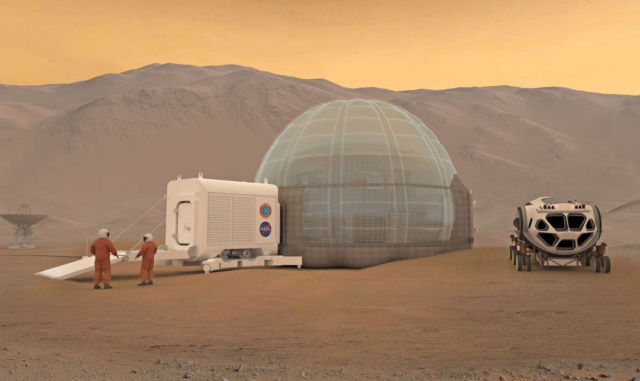NASA just announced the new ice shelter home for astronauts on Mars.
When astronauts set foot on Mars, they may stay for months rather than days as they did during Apollo missions to the moon. The surface of Mars has extreme temperatures and the atmosphere does not provide adequate protection from high-energy radiation. These explorers will need shelters to effectively protect them from the harsh Martian environment and provide a safe place to call home.
Above, an artist’s rendering of the Mars Ice Home concept. Credit NASA/Clouds AO/SEArch
For researchers at NASA’s Langley Research Center in Hampton, Virginia, the best building material for a new home on Mars may lie in an unexpected material: ice.
Starting with a proposed concept called “Mars Ice Dome,” a group of NASA experts and passionate designers and architects from industry and academia came together at Langley’s Engineering Design Studio. The project was competitively selected through the Space Technology Mission Directorate’s (STMD) Center Innovation Fund to encourage creativity and innovation within the NASA Centers in addressing technology needs. This is just one of many potential concepts for sustainable habitation on the Red Planet in support of the agency’s journey to Mars.
“After a day dedicated to identifying needs, goals and constraints we rapidly assessed many crazy, out of the box ideas and finally converged on the current Ice Home design, which provides a sound engineering solution,” said Langley senior systems engineer Kevin Vipavetz, facilitator for the design session.
The team at Langley had assistance in their concept study, as a collaborative team from Space Exploration Architecture and the Clouds Architecture Office that produced a first-prize winning entry for the NASA Centennial Challenge for a 3D-printed habitat (Mars Ice House) played a key role in the design session.
The “Mars Ice Home” is a large inflatable torus, a shape similar to an inner tube, that is surrounded by a shell of water ice. The Mars Ice Home design has several advantages that make it an appealing concept. It is lightweight and can be transported and deployed with simple robotics, then filled with water before the crew arrives. It incorporates materials extracted from Mars, and because water in the Ice Home could potentially be converted to rocket fuel for the Mars Ascent Vehicle, the structure itself doubles as a storage tank that can be refilled for the next crew.
source:






Leave A Comment